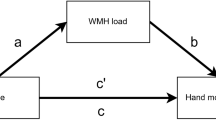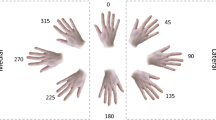Abstract
Abnormal substantia nigra morphology in healthy individuals, viewed with transcranial ultrasound, is a significant risk factor for Parkinson’s disease. However, little is known about the functional consequences of this abnormality (termed ‘hyperechogenicity’) on movement. The aim of the current study was to investigate hand function in healthy older adults with (SN+) and without (SN−) substantia nigra hyperechogenicity during object manipulation. We hypothesised that SN+ subjects would exhibit increased grip force and a slower rate of force application compared to SN− subjects. Twenty-six healthy older adults (8 SN+ aged 58 ± 8 years, 18 SN− aged 57 ± 6 years) were asked to grip and lift a light-weight object with the dominant hand. Horizontal grip force, vertical lift force, acceleration, and first dorsal interosseus EMG were recorded during three trials. During the first trial, SN+ subjects exhibited a longer period between grip onset and lift onset (i.e. preload duration; 0.27 ± 0.25 s) than SN− subjects (0.13 ± 0.08 s; P = 0.046). They also exerted a greater downward force prior to lift off (−0.54 ± 0.42 N vs. −0.21 ± 0.12 N; P = 0.005) and used a greater grip force to lift the object (19.5 ± 7.0 N vs. 14.0 ± 4.3 N; P = 0.022) than SN− subjects. No between group differences were observed in subsequent trials. SN+ subjects exhibit impaired planning for manipulation of new objects. SN+ individuals over-estimate the grip force required, despite a longer contact period prior to lifting the object. The pattern of impairment observed in SN+ subjects shares similarities with de novo Parkinson’s disease patients.





Similar content being viewed by others
References
Abikoff H, Alvir J, Hong G, Sukoff R, Orazio J, Solomon S, Saravay S (1987) Logical memory subtest of the Wechsler Memory Scale: age and education norms and alternate-form reliability of two scoring systems. J Clin Exp Neuropsychol 9:435–448. doi:10.1080/01688638708405063
Anstey KJ, Matters B, Brown AK, Lord SR (2000) Normative data on neuropsychological tests for very old adults living in retirement villages and hostels. Clin neuropsychol 14:309–317. doi:10.1076/1385-4046(200008)14:3;1-P;FT309
Beck AT, Steer RA, Brown GK (1996) Manual for the beck depression inventory-II. The Psychological Corporation, San Antonio
Behnke S, Schroeder U, Dillmann U, Buchholz HG, Schreckenberger M, Fuss G, Reith W, Berg D, Krick CM (2009) Hyperechogenicity of the substantia nigra in healthy controls is related to MRI changes and to neuronal loss as determined by F-Dopa PET. Neuroimage 47:1237–1243. doi:10.1016/j.neuroimage.2009.05.072
Benton AL, Hamsher K (1983) Multilingual aphasia examination. AJA Associates, Iowa City
Berg D, Becker G, Zeiler B, Tucha O, Hofmann E, Preier M, Benz P, Jost W, Reiners K, Lange KW (1999a) Vulnerability of the nigrostriatal system as detected by transcranial ultrasound. Neurology 53:1026–1031
Berg D, Grote C, Rausch WD, Maurer M, Wesemann W, Riederer P, Becker G (1999b) Iron accumulation in the substantia nigra in rats visualized by ultrasound. Ultrasound Med Biol 25:901–904
Berg D, Siefker C, Becker G (2001a) Echogenicity of the substantia nigra in Parkinson’s disease and its relation to clinical findings. J Neurol 248:684–689
Berg D, Siefker C, Ruprecht-Dorfler P, Becker G (2001b) Relationship of substantia nigra echogenicity and motor function in elderly subjects. Neurology 56:13–17
Berg D, Roggendorf W, Schroder U, Klein R, Tatschner T, Benz P, Tucha O, Preier M, Lange KW, Reiners K, Gerlach M, Becker G (2002) Echogenicity of the substantia nigra: association with increased iron content and marker for susceptibility to nigrostriatal injury. Arch Neurol 59:999–1005
Berg D, Godau J, Walter U (2008) Transcranial sonography in movement disorders. Lancet Neurol 7:1044–1055. doi:10.1016/S1474-4422(08)70239-4
Berg D, Godau J, Riederer P, Gerlach M, Arzberger T (2010) Microglia activation is related to substantia nigra echogenicity. J Neural Transm 117:1287–1292. doi:10.1007/s00702-010-0504-6
Berg D, Behnke S, Seppi K, Godau J, Lerche S, Mahlknecht P, Liepelt-Scarfone I, Pausch C, Schneider N, Gaenslen A, Brockmann K, Srulijes K, Huber H, Wurster I, Stockner H, Kiechl S, Willeit J, Gasperi A, Fassbender K, Gasser T, Poewe W (2013) Enlarged hyperechogenic substantia nigra as a risk marker for Parkinson’s disease. Mov Disord 28:216–219. doi:10.1002/mds.25192
Busse K, Heilmann R, Kleinschmidt S, Abu-Mugheisib M, Hoppner J, Wunderlich C, Gemende I, Kaulitz L, Wolters A, Benecke R, Walter U (2012) Value of combined midbrain sonography, olfactory and motor function assessment in the differential diagnosis of early Parkinson’s disease. J Neurol Neurosurg Psychiatry 83:441–447. doi:10.1136/jnnp-2011-301719
Darian-Smith I, Galea MP, Darian-Smith C (1996) Manual dexterity: how does the cerebral cortex contribute? Clin Exp Pharm Physiol 23:948–956
Doepp F, Plotkin M, Siegel L, Kivi A, Gruber D, Lobsien E, Kupsch A, Schreiber SJ (2008) Brain parenchyma sonography and 123I-FP-CIT SPECT in Parkinson’s disease and essential tremor. Mov Disord 23:405–410. doi:10.1002/mds.21861
Fahn S, Elton RL (1987) The Unified Parkinson’s Disease Rating Scale. In: Fahn S, Marsden CD, Calne DB, Goldstein M (eds) Recent developments in Parkinson’s disease. MacMillan Healthcare Information, Florham Park, New York, pp 153–163, 293–304
Fellows SJ, Noth J (2004) Grip force abnormalities in de novo Parkinson’s disease. Mov Disord 19:560–565. doi:10.1002/mds.10710
Flanagan JR, Bowman MC, Johansson RS (2006) Control strategies in object manipulation tasks. Curr Opin Neurobiol 16:650–659. doi:10.1016/j.conb.2006.10.005
Gaenslen A, Unmuth B, Godau J, Liepelt I, Di Santo A, Schweitzer KJ, Gasser T, Machulla HJ, Reimold M, Marek K, Berg D (2008) The specificity and sensitivity of transcranial ultrasound in the differential diagnosis of Parkinson’s disease: a prospective blinded study. Lancet Neurol 7:417–424. doi:10.1016/S1474-4422(08)70067-X
Gordon AM, Westling G, Cole KJ, Johansson RS (1993) Memory representations underlying motor commands used during manipulation of common and novel objects. J Neurophysiol 69:1789–1796
Grigsby J, Kaye K (1995) Alphanumeric sequencing and cognitive impairment among elderly persons. Percept Mot Skills 80:732–734
Hurley MJ, Mash DC, Jenner P (2003) Markers for dopaminergic neurotransmission in the cerebellum in normal individuals and patients with Parkinson’s disease examined by RT-PCR. Eur J Neurosci 18:2668–2672
Ingvarsson PE, Gordon AM, Forssberg H (1997) Coordination of manipulative forces in Parkinson’s disease. Exp Neurol 145:489–501
Johansson RS (1998) Sensory input and control of grip. Novartis Found Symp 218:45–59 (discussion 59–63)
Kear-Colwell JJ, Heller M (1978) A normative study of the Wechsler Memory Scale. J Clin Psychol 34:437–442
Liepelt I, Behnke S, Schweitzer K, Wolf B, Godau J, Wollenweber F, Dillmann U, Gaenslen A, Di Santo A, Maetzler W, Berg D (2011) Pre-motor signs of PD are related to SN hyperechogenicity assessed by TCS in an elderly population. Neurobiol Aging 32:1599–1606. doi:10.1016/j.neurobiolaging.2009.10.004
Lobsien E, Schreiner S, Plotkin M, Kupsch A, Schreiber SJ, Doepp F (2012) No correlation of substantia nigra echogenicity and nigrostriatal degradation in Parkinson’s disease. Mov Disord 27:450–453. doi:10.1002/mds.24070
Lovibond SH, Lovibond PF (1995) Manual for the Depression Anxiety Stress Scales, 2nd edn. Psychological Foundation, Sydney
MacDonald V, Halliday GM (2002) Selective loss of pyramidal neurons in the pre-supplementary motor cortex in Parkinson’s disease. Mov Disord 17:1166–1173
Manto M, Bower JM, Conforto AB, Delgado-Garcia JM, da Guarda SN, Gerwig M, Habas C, Hagura N, Ivry RB, Marien P, Molinari M, Naito E, Nowak DA, Oulad Ben Taib N, Pelisson D, Tesche CD, Tilikete C, Timmann D (2012) Consensus paper: roles of the cerebellum in motor control—the diversity of ideas on cerebellar involvement in movement. Cerebellum 11:457–487. doi:10.1007/s12311-011-0331-9
Mehnert S, Reuter I, Schepp K, Maaser P, Stolz E, Kaps M (2010) Transcranial sonography for diagnosis of Parkinson’s disease. BMC Neurol 10:9. doi:10.1186/1471-2377-10-9
Mrazik M, Millis S, Drane DL (2010) The oral trail making test: effects of age and concurrent validity. Arch Clin Neuropsychol 25:236–243. doi:10.1093/arclin/acq006
Oldfield RC (1971) The assessment and analysis of handedness: the Edinburgh inventory. Neuropsychologia 9:97–113
Rossi S, Hallett M, Rossini PM, Pascual-Leone A (2009) Safety, ethical considerations, and application guidelines for the use of transcranial magnetic stimulation in clinical practice and research. Clin Neurophysiol 120:2008–2039. doi:10.1016/j.clinph.2009.08.016
Spiegel J, Hellwig D, Mollers MO, Behnke S, Jost W, Fassbender K, Samnick S, Dillmann U, Becker G, Kirsch CM (2006) Transcranial sonography and [123I]FP-CIT SPECT disclose complementary aspects of Parkinson’s disease. Brain 129:1188–1193. doi:10.1093/brain/awl042
Todd G, Gandevia SC, Taylor JL (2010a) Change in manipulation with muscle fatigue. Eur J Neurosci 32:1686–1694. doi:10.1111/j.1460-9568.2010.07444.x
Todd G, Taylor JL, Baumann D, Butler JE, Duma SR, Hayes M, Carew-Jones F, Piguet O, Behnke S, Ridding MC, Berg D, Double KL (2010b) Substantia nigra echomorphology and motor cortex excitability. Neuroimage 50:1351–1356. doi:10.1016/j.neuroimage.2010.01.088
Tombaugh TN, Kozak J, Rees L (1999) Normative data stratified by age and education for two measures of verbal fluency: FAS and animal naming. Arch Clin Neuropsychol 14:167–177 (pii:S0887617797000954)
Tsai CF, Wu RM, Huang YW, Chen LL, Yip PK, Jeng JS (2007) Transcranial color-coded sonography helps differentiation between idiopathic Parkinson’s disease and vascular parkinsonism. J Neurol 254:501–507. doi:10.1007/s00415-006-0403-9
Vaillancourt DE, Slifkin AB, Newell KM (2001) Visual control of isometric force in Parkinson’s disease. Neuropsychologia 39:1410–1418. pii:S0028393201000616
van de Loo S, Walter U, Behnke S, Hagenah J, Lorenz M, Sitzer M, Hilker R, Berg D (2010) Reproducibility and diagnostic accuracy of substantia nigra sonography for the diagnosis of Parkinson’s disease. J Neurol Neurosurg Psychiatry 81:1087–1092. doi:10.1136/jnnp.2009.196352
Walter U, Hoeppner J, Prudente-Morrissey L, Horowski S, Herpertz SC, Benecke R (2007) Parkinson’s disease-like midbrain sonography abnormalities are frequent in depressive disorders. Brain 130:1799–1807. doi:10.1093/brain/awm017
Wechsler D (1981) Wechsler adult intelligence scale—revised. Psychological Corporation, New York
Wechsler D (1987) Wechsler memory scale—revised. Psychological Corporation, New York
Westling G, Johansson RS (1984) Factors influencing the force control during precision grip. Exp Brain Res 53:277–284
Zecca L, Berg D, Arzberger T, Ruprecht P, Rausch WD, Musicco M, Tampellini D, Riederer P, Gerlach M, Becker G (2005) In vivo detection of iron and neuromelanin by transcranial sonography: a new approach for early detection of substantia nigra damage. Mov Disord 20:1278–1285. doi:10.1002/mds.20550
Acknowledgments
The authors would like to thank the Flinders Medical Centre Ultrasound Department for assistance with data collection. This work was supported by research funding from Parkinson’s South Australia (GT holds a research grant, PLF holds a Norman Weir Scholarship), Coopers Brewery Foundation, The Rebecca L Cooper Medical Research Foundation, University of South Australia, and the National Health and Medical Research Council of Australia (GT and OP hold Career Development Fellowships (ID627003 and APP1022684, respectively), CR, JT, and KLD hold/held Senior Research Fellowships, SCG holds a Senior Principal Research Fellowship). We are grateful for a research donation from the 2011 ‘Long Table Dinner’.
Conflict of interest
The authors declare that they have no conflict of interest.
Author information
Authors and Affiliations
Corresponding author
Rights and permissions
About this article
Cite this article
Todd, G., Haberfield, M., Faulkner, P.L. et al. Hand function is impaired in healthy older adults at risk of Parkinson’s disease. J Neural Transm 121, 1377–1386 (2014). https://doi.org/10.1007/s00702-014-1218-y
Received:
Accepted:
Published:
Issue Date:
DOI: https://doi.org/10.1007/s00702-014-1218-y




